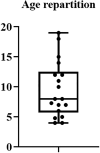Pharmacological management of cherubism: A systematic review
- PMID: 36998472
- PMCID: PMC10044089
- DOI: 10.3389/fendo.2023.1104025
Pharmacological management of cherubism: A systematic review
Abstract
Objective: The aim of this systematic review was to determine if there exists an efficacious drug treatment for cherubism, based on published studies.
Methods: This systematic review included observational case studies reporting pharmacological management of cherubism. We developed specific search strategies for PubMed (including Medline), ScienceDirect, Web of Science. We evaluated the methodological quality of the included studies using criteria from the Joanna Briggs Institute's critical appraisal tools.
Results: Among the 621 studies initially identified by our search script, 14 were selected for inclusion, of which five were classified as having a low risk of bias, four as having an unclear risk, and five a high risk. Overall, 18 cherubism patients were treated. The sample size in each case study ranged from one to three subjects. This review identified three types of drugs used for cherubism management: calcitonin, immunomodulators and anti-resorptive agents. However, the high heterogeneity in case reports and the lack of standardized outcomes precluded a definitive conclusion regarding the efficacy of any treatment for cherubism.
Conclusions: The present systematic review could not identify an effective treatment for cherubism due to the heterogeneity and limitations of the included studies. However, in response to these shortcomings, we devised a checklist of items that we recommend authors consider in order to standardize the reporting of cherubism cases and specifically when a treatment is given toward identification of an efficacious cherubism therapy.
Systematic review registration: https://www.crd.york.ac.uk/prospero/display_record.php?ID=CRD42022351044, identifier CRD42022351044.
Keywords: cherubism; drug; management – healthcare; pharmacological treatment; systematic review.
Copyright © 2023 Cailleaux, Porporatti, Cohen-Solal, Kadlub and Coudert.
Conflict of interest statement
The authors declare that the research was conducted in the absence of any commercial or financial relationships that could be construed as a potential conflict of interest.
Figures



References
Publication types
MeSH terms
LinkOut - more resources
Full Text Sources

